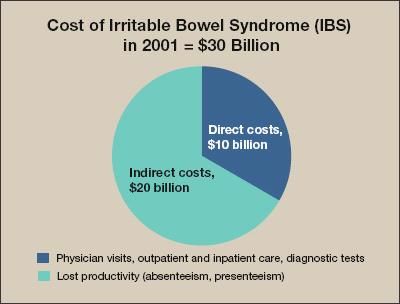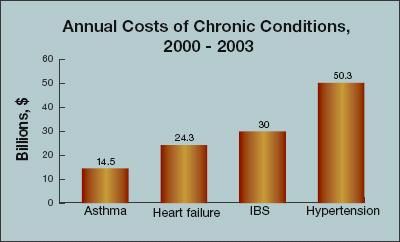Employers Bear Cost Burden of Irritable Bowel Syndrome
Currently, an estimated 20% of the adult US population have irritable bowel syndrome (IBS). Although the disorder affects both sexes, between 60% and 75% of persons who receive a diagnosis of IBS are women. IBS develops before age 35 in approximately 50% of those with the disorder. Between 5% and 20% of children and 6% to 14% of adolescents have symptoms of IBS.
Currently, an estimated 20% of the adult US population have irritable bowel syndrome (IBS). Although the disorder affects both sexes, between 60% and 75% of persons who receive a diagnosis of IBS are women. IBS develops before age 35 in approximately 50% of those with the disorder. Between 5% and 20% of children and 6% to 14% of adolescents have symptoms of IBS.
Approximately $30 billion in direct and indirect costs is spent annually in the United States on IBS (Figure 1). Direct costs associated with IBS are estimated to be $10 billion annually; this figure includes visits to primary care physicians and specialists, outpatient and inpatient care, and diagnostic testing, and excludes prescription and OTC medications. Indirect costs, including productivity losses in the workplace, make up the other two thirds.

Figure 1. The annual indirect costs associated with IBS are twice as high as direct costs and account for two thirds of the total. Source: Hulisz D.The burden of illness of irritable bowel syndrome: current challenges and hope for the future. J Manag Care Pharm. 2004;10:299-309.
The total annual cost of IBS is comparable with that of other common chronic conditions, including asthma, hypertension, and heart failure. The CDC estimated the total cost of asthma in the United States in 2000 to be $14.5 billion. The American Heart Association reported the cost of hypertension and heart failure in the United States in 2003 to be $50.3 billion and $24.3 billion, respectively (Figure 2).

Figure 2. The total annual costs associated with irritable bowel syndrome (IBS) are comparable with those of common chronic disorders including hypertension, heart failure, and asthma. Source: Hulisz D. J Manag Care Pharm. 2004;10:299-309.
Employees with no/mild, moderate, or severe symptoms of IBS self-reported absenteeism (2.5%, 3.7%, and 10.1%, respectively) and presenteeism (22.2%, 36.6%, and 38.6%, respectively) (Figure 3), according to a report by Reilly and colleagues published in Alimentary Pharmacology and Therapeutics in 2004. This is the equivalent of 9.7 to 14 hours of lost work productivity per week.

Figure 3. Absenteeism and presenteeism increase with the severity of IBS symptoms. Source: Reilly MC, Bracco A, Ricci JF, et al. The validity and accuracy of the Work Productivity and Activity Impairment questionnaire-irritable bowel syndrome version (WPAI:IBS). Aliment Pharmacol Ther. 2004;20:459-467.
Although only 25% to 30% of persons with IBS seek treatment, they are frequent users of the health care system. IBS accounts for 12% and 28% of diagnoses made by physicians and gastroenterologists, respectively.
Newsletter
Enhance your clinical practice with the Patient Care newsletter, offering the latest evidence-based guidelines, diagnostic insights, and treatment strategies for primary care physicians.